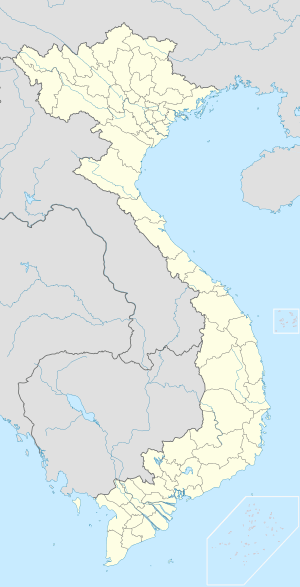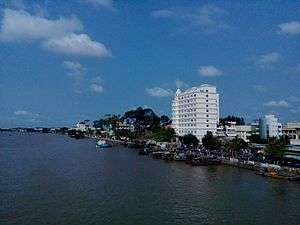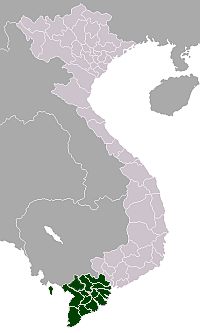Bến Tre
| Bến Tre City Thành phố Bến Tre | |
|---|---|
| Provincial city | |
|
A view of Ben Tre city | |
 Bến Tre City Location of in Vietnam | |
| Coordinates: 10°14′N 106°23′E / 10.233°N 106.383°E | |
| Country |
|
| Province | Bến Tre |
| Area | |
| • Provincial city | 71.11 km2 (27.46 sq mi) |
| Population (January 2016) | |
| • Provincial city | 231,904 |
| • Density | 3,261.2/km2 (8,446/sq mi) |
| • Urban | 190,161 |
Bến Tre (![]() listen) is the capital city of Bến Tre Province, in the Mekong Delta area of southern Vietnam. The city covers an area of 65.75 km2 and has a population of 143,639 as of 2009.[1]
Bến Tre is 85 kilometres (53 mi) south-east of Ho Chi Minh City and is connected to the surrounding provinces by the Rạch Miễu Bridge. Nearly destroyed by Allied bombing, it played a significant role in the Vietnam War. Reports of the assault and resulting civilian casualties called into question the war aims of the United States.
listen) is the capital city of Bến Tre Province, in the Mekong Delta area of southern Vietnam. The city covers an area of 65.75 km2 and has a population of 143,639 as of 2009.[1]
Bến Tre is 85 kilometres (53 mi) south-east of Ho Chi Minh City and is connected to the surrounding provinces by the Rạch Miễu Bridge. Nearly destroyed by Allied bombing, it played a significant role in the Vietnam War. Reports of the assault and resulting civilian casualties called into question the war aims of the United States.
Geolocation
Bến Tre is located on Bảo Island, with the districts of Châu Thành, Giồng Trôm and Ba Tri. The city is oriented in a triangular layout and is bordered by the following districts:[1]
- North and east by districts of Châu Thành.
- South by districts of Giồng Trôm.
- Hàm Luông River in the west, separating the city from the districts of Mỏ Cày Bắc.
Administration
The city of Bến Tre has 10 wards: 1, 2, 3, 4, 5, 6, 7, 8, Phú Khương, Phú Tân and 7 communes of Bình Phú, Mỹ Thành, Mỹ Thạnh An, Nhơn Thạnh, Phú Hưng, Phú Nhuận and Sơn Đông.
History
The French occupied Bến Tre in 1867.[2]
Vietnam War
A famous quote from the Vietnam War was a statement attributed to an unnamed U.S. officer by AP correspondent Peter Arnett in his writing about Bến Tre city on 7 February 1968:
'It became necessary to destroy the town to save it', a United States major said today. He was talking about the decision by allied commanders to bomb and shell the town regardless of civilian casualties, to rout the Vietcong.[3]
The quote became distorted in subsequent publications, eventually becoming the more familiar, "We had to destroy the village in order to save it."[4] Victor Davis Hanson, writing for the conservative National Review Online, has called into question the accuracy of the original quote and its source.[5]
Arnett never completely revealed his source, but he did say that it came from one of the four officers he interviewed that day. United States Army Major Phil Cannella, the senior officer present at Bến Tre, suggested that the quote might have been a distortion of something he had said to Arnett.[4] At the time, The New Republic attributed the quote to U.S. Air Force Major Chester L. Brown.[6]
In Walter Cronkite's 1971 book, Eye on the World, Arnett re-asserted that the quote was something "one American major said to me in a moment of revelation."[7] However, American veteran Captain Michael D. Miller wrote in 2006 that he heard the comment being made by a Major Booris at a press briefing.[8]
Notable people
- Sister Chan Khong - Nun who has worked closely with Zen master Thich Nhat Hanh for more than fifty years
Schools
References
- 1 2 Nghị quyết số 34/NQ-CP về việc thành lập thành phố Bến Tre thuộc tỉnh Bến Tre do Chính phủ ban hành (Decision by the Vietnamese government on the establishment of Ben Tre City)
- ↑ Thạch Phương, Tứ Đoàn, Phương Thảo Nguyễn Địa chí Bến Tre 1991 "Only in Bao and Minh islets, there had been 70 schools of Chinese characters in 152 villages until the French occupied Ben Tre (1867). That was a very rare proportion at that time. The list of the Ben Tre successful candidates written in the...."
- ↑ "Major Describes Move". New York Times. 8 February 1968.
- 1 2 Keyes, Ralph (2006). The Quote Verifier: Who Said What, Where, and When. St. Martin's Griffin. ISBN 978-0-312-34004-9.
- ↑ Victor Davis Hanson, "Misplaced Metaphors" Archived November 6, 2011, at the Wayback Machine., NRO, 24 November 2004
- ↑ Braestrup, Peter (1977). Big Story: How the American Press and Television Reported and Interpreted the Crisis of Tet 1968 in Vietnam and Washington, Volume 1. Westview Press. p. 259. ISBN 9780891580126.
- ↑ Cronkite, Walter (1971). Eye on the World. Cowles Book Company.
- ↑ "Saving Ben Tre". Elk Hunting Wisdom. October 25, 2008.
External links
| Wikivoyage has a travel guide for Ben Tre. |
- Ben Tre - The third Coconut Festival 2012
- Tuổi Trẻ Bến Tre
- Official website of Ben Tre province (English ver.)
- Michael D. Miller. Saving Ben Tre: American veteran's account of Bến Tre during the Tet Offensive
Coordinates: 10°14′N 106°23′E / 10.233°N 106.383°E

